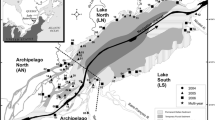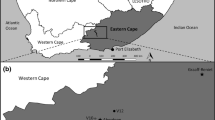Abstract
Historical changes (1961–2002) in the distribution of herbaceous wetland plant associations were inferred from the hydrological regime of Lake Saint-Pierre, a 312 km2 broadening of the St. Lawrence River (Quebec, Canada), to assess the cumulative effects of human interventions and climatic variability. Relative abundance index (height × percent cover) of wetland plants in 630 field quadrats sampled at 13 sites (1999–2002) were used to derive a model predicting the occurrence of nine herbaceous plant classes with a 71% (24–84%) accuracy. Wetland types included seasonally dry (meadows), mudflats and wet (low marshes and submerged) assemblages. Over the 1961–2002 period, the total surface area of Lake Saint-Pierre herbaceous wetlands ranged between 11 (in 1972) and 128 (in 2001) km2 and was negatively correlated (Spearman r = −0.86, p < 0.0001) to average water level during the current growing season. Within-season variability and level conditions over the previous season defined 5 marsh assemblages characterized by different species composition, relative abundance and diversity. Significant hydrological variables included quadrat elevation, water depth, number of days flooded and depth variability experienced over the current and/or previous growth seasons. The hydrological model suggests that for a given level, wetland plant assemblages differed markedly whether the multi-year sequence of water levels was rising or falling. Lake Saint-Pierre alternated between three broad-scale wetland configurations, dominated by meadows and open marsh with floating-leaved vegetation (in the 1960s), scattered tall Scirpus marshes (in the 1970s and early 1980s) and closed marsh with aggressive emergents (since 1996). The strong response of Lake Saint-Pierre wetlands to hydrological conditions in the current and previous growth seasons underlines their vulnerability to future water level variations resulting from regulation and climate variability.
Similar content being viewed by others
References
L. Breiman J. Friedman R. Ohlsen C. Stone (1984) Classification and Regression Trees Wadsworth Belmont, CA
S.E. Bunn AH. Arthington (2002) ArticleTitleBasic principles and ecological consequences of altered flow regimes for aquatic biodiversity Environmental Management 30 492–507 Occurrence Handle10.1007/s00267-002-2737-0 Occurrence Handle12481916
Buteau, P., N. Dignard Grondin P., 1994. Système de classification des milieux humides du Québec. MB 94-01. Gouvernement du Québec, Ministère des Ressources Naturelles, Secteur des mines, 25 pp
S.R. Carpenter DM. Lodge (1986) ArticleTitleEffects of submersed macrophytes on ecosystem processes Aquatic Botany 26 341–370 Occurrence Handle10.1016/0304-3770(86)90031-8
A. Carpentier (2003) ArticleTitleLa régularisation du Saint-Laurent Le Naturaliste Canadien 127 102–113
J.M. Casselman CA. Lewis (1996) ArticleTitleHabitat requirements of northern pike (Esox lucius) Canadian Journal of Fisheries and Aquatic Sciences 53 IssueIDsuppl. 1 161–174 Occurrence Handle10.1139/cjfas-53-S1-161
P.A. Chambers RE. DeWreede E.A. Irlandi H. Vandermeulen (1999) ArticleTitleManagement issues in aquatic macrophyte ecology: a Canadian perspective Canadian Journal of Fisheries and Aquatic Sciences 77 471–487
Cléonique-Joseph, F., 1936. Étude de développement floristique en Laurentie. Contributions du Laboratoire de Botanique de l’Université de Montréal No. 27
Dansereau, P., 1959. Phytogeographia Laurentiana. II. The principal plant associations of the St. Lawrence River Valley. Contributions de l’Institut Botanique de l’Université de Montréal 75, p. 148
R.T. Day PA. Keddy J. McNeill T. Carleton (1988) ArticleTitleFertility and disturbance gradients: a summary model for riverine marsh vegetation Ecology 69 1044–1054
H. Décamps A.M. Planty-Tabacchi A. Tabacchi (1995) ArticleTitleChanges in the hydrological regime and invasions by plant species along riparian systems of the Adour river, France Regulated Rivers – Research Management 11 23–33
EC, Environment Canada, 1996. State of the Environment Report on the St. Lawrence River. Volumes 1 and 2. St. Lawrence Update Series. St. Lawrence Centre. Environment Canada – Quebec Region, Conservation Branch and Éditions MultiMondes, Montreal, Quebec, Canada
Fleurbec (1987) Plantes sauvages des lacs, rivières et tourbières Groupe Fleurbec. Guide d’identification Fleurbec. Saint-Augustin (Portneuf) Quebec, Canada
Gauthier, B., 1997. Politique de protection des rives, du littoral et des plaines inondables. Direction de la conservation et du patrimoine écologique. Ministère de l’Environnement et de la Faune du Québec, 25 pp
Herdendorf, C. E., S. M. Hartley M. D. Barnes (eds), 1981. Fish and Wildlife Resources of the Great Lakes Coastal Wetlands within the United States, Volume I. U.S. Fish Wildlife Service, Washington, DC, 469 pp
N.M. Hill P.A. Keddy IC. Wisheu (1998) ArticleTitleA hydrological model for predicting the effects of dams on the shoreline vegetation of lakes and reservoirs Environmental Management 22 723–736 Occurrence Handle10.1007/s002679900142 Occurrence Handle9680540
C. Hudon (1997) ArticleTitleImpact of water-level fluctuations on St Lawrence River aquatic vegetation. Canadian Journal of Fisheries and Aquatic Sciences 54 2853–2865
C. Hudon (2004) ArticleTitleShift in wetland plant composition and biomass following low-level episodes in the St Lawrence River: looking into the future. Canadian Journal of Fisheries and Aquatic Sciences 61 603–617
M. Jean A. Bouchard (1991) ArticleTitleTemporal changes in wetland landscapes of a section of the St Lawrence River, Canada. Environmental Management 15 241–250
Jean, M., G. Létourneau, C. Lavoie Delisle F., 2002. Les milieux humides et les plantes exotiques en eau douce. Bureau de coordination de Saint-Laurent Vision 2000, Sainte-Foy, Quebec, Canada, 8 pp
R.M. Kaminski HH. Prince (1981) ArticleTitleDabbling duck and aquatic macroinvertebrate responses to manipulated wetland habitat Journal of Wildlife Management 45 1–15
P.A. Keddy (1989) ArticleTitleEffects of competition from shrubs on herbaceous wetland plants: a 4-year field experiment Canadian Journal of Botany 67 708–716
P.A. Keddy (2002) Wetland Ecology – Principles and Conservation, Cambridge Studies in Ecology EditionNumber2 Cambridge University Press Cambridge 618
P.A. Keddy AA. Reznicek (1986) ArticleTitleGreat Lakes vegetation dynamics: the role of fluctuating water levels and buried seeds Journal of Great Lakes Research 12 25–36
Keetch, J. Byram GM., 1968. A drought index for forest fire control. Forest Experimental Station, USDA Forest Service Research SE-38, 32 pp
Lalonde, S. G. Létourneau, 1996. Sensibilité de la télédétection spatiale pour le suivi des milieux humides. St. Lawrence Centre, Environment Canada – Quebec Region, Montreal, Quebec, Canada
G.N. Lance WT. Williams (1967) ArticleTitleA general theory of classificatory sorting strategies, I Hierarchical systems. Computer Journal 9 373–380
C. Lavoie M. Jean F. Delisle G. Létourneau (2003) ArticleTitleExotic plant species of the St Lawrence River Wetlands: a spatial and historical analysis. Journal of Biogeography 30 537–549
Legendre L., Legendre P. (1983). Numerical Ecology, 2nd edn. Developments in Environmental Modelling,Vol. 3. Elsevier, Amsterdam, 419 pp
Fr. Marie-Victorin (1934) ArticleTitleLe fleuve Saint-Laurent, milieu biologique pour les plantes vasculaires Trans. Royal Society of Canada Section V, Series III 28 17
Fr. Marie-Victorin (1943) ArticleTitleObservations botaniques sur les effets d’une exceptionnelle baisse de niveau du Saint-Laurent durant l’été de 1931 Contributions de l’Institut Botanique de l’Université de Montréal 48 21–28
Marie-Victorin Fr. (1995). Flore laurentienne, 3rd edition updated and annotated by Luc Brouillet et al., Presses de l’Université de Montréal, Quebec, Canada, 1093 pp
J.J. Magnuson KE. Webster RA. Assel CJ. Bowser PJ. Dillon JG. Eaton HE. Evans EJ. Fee RI. Hall LR. Mortsch D.W. Schindler FH. Quinn (1997) Potential effects of climate changes on aquatic systems: Laurentian Great Lakes and Precambrian Shield Regional Hydrological Proceedings 11 825–871
MENV, Ministère de l’environnement, 2003. Synthèse des informations environnementales disponibles en matière agricole au Québec. Direction de politiques du secteur agricole, ministère de l’Environnement, Québec, Envirodoq ENV/2003/0025, 143 pp
Morin, J. Bouchard A., 2001. Les bases de la modélisation du Tronçon Montréal/Trois-Rivières. Scientific Report RS-100. Meteorological Service of Canada. Hydrology, Environment Canada – Quebec Region, Sainte-Foy, Quebec, Canada
C. Nilsson PA. Keddy (1988) ArticleTitlePredictability of change in shoreline vegetation in a hydroelectric reservoir, northern Sweden Canadian Journal of Fisheries and Aquatic Sciences 45 1896–1904
C. Nilsson M. Svedmark (2002) ArticleTitleBasic principles and ecological consequences of changing water regimes: riparian plant communities Environmental Management 30 468–480 Occurrence Handle12481914
G.E. Petts (1984) Impounded Rivers – Perspectives for Ecological Management Wiley–Interscience John Wiley Sons New York
N.L. Poff JD. Allan MB. Bain JR. Karr KL. Prestegaard BD. Richter R.E. Sparks JC. Stromberg (1997) ArticleTitleThe natural flow regime – A paradigm for river conservation and restoration BioScience 47 769–784
Reed, P. B., 1988. National List of Plant Species that Occur in Wetlands: National Summary. Biological Report 88 (24). US Fish Wildlife Service
B. Shipley P.A. Keddy LP. Lefkovitch (1991) ArticleTitleMechanisms producing plant zonation along a water depth gradient: a comparison with the exposure gradient Canadian Journal of Botany 69 1420–1424
Ter Braak C.J.F., Smilauer P. (1998). Reference Manual and User’s Guide to Canoco for Windows: Software for Canonical Community Ordination (version 4). Microcomputer Power. Ithaca, NY, USA, 352 pp
M. Toner PA. Keddy (1997) ArticleTitleRiver hydrology and riparian wetlands: a predictive model for ecological assembly Ecological Applications 7 236–246
A.G. Van der Valk (1994) ArticleTitleEffects of prolonged flooding on the distribution and biomass of emergent species along a freshwater wetland coenocline Vegetatio 110 185–196
A.G. Van der Valk C.B. Davis (1978) ArticleTitleThe role of seed banks in the vegetation dynamics of prairie glacial marshes Ecology 59 322–335
J.V. Ward K. Tockner F. Schiemer (1999) ArticleTitleBiodiversity of floodplain river ecosystems: ecotones and connectivity Regulated Rivers – Research Management 15 125–139
D.A. Wilcox TH. Whillans (1999) ArticleTitleTechniques for restoration of disturbed coastal wetlands of the Great Lakes Wetlands 19 835–857
D.A. Wilcox JE. Meeker PL. Hudson BJ. Armitage M.G. Black DG. Uzarski (2002) ArticleTitleHydrologic variability and the application of Index of Biotic Integrity metrics to wetlands: a Great Lakes evaluation Wetlands 22 588–615
Author information
Authors and Affiliations
Corresponding author
Rights and permissions
About this article
Cite this article
Hudon, C., Gagnon, P., Amyot, JP. et al. Historical changes in herbaceous wetland distribution induced by hydrological conditions in Lake Saint-Pierre (St. Lawrence River, Quebec, Canada). Hydrobiologia 539, 205–224 (2005). https://doi.org/10.1007/s10750-004-4872-5
Issue Date:
DOI: https://doi.org/10.1007/s10750-004-4872-5




